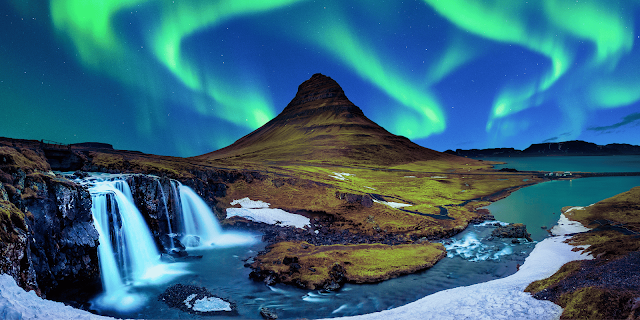With spectacular glaciers, geothermal hot springs, and some of the best chances in the world to see the Northern Lights, Iceland is a destination like no other. As an Arctic Island situated between the North Atlantic and Arctic oceans, Iceland offers visitors incredible natural beauty and phenomena. In this guide, we'll cover everything you need to know to plan an epic Iceland adventure including when to go, what to see and do, and how to maximize your chances of experiencing this country's top attractions.
When to Visit
Firstly, you'll want to consider when the best time is to visit Iceland based on what you want to see and experience. While there is beauty to be found in Iceland during any season, certain months offer optimal conditions for specific activities.
Winter Northern Lights Season (September - April)
For the best chances of seeing the elusive Northern Lights, your ideal months are between September and April. The skies are darker this time of year and solar activity is higher, resulting in more frequent and brighter displays of the Aurora Borealis. However, you'll have to brace yourself for short winter days and possible cold, snowy conditions.
Summer Glacier Season (June - August)
If you want to experience Iceland's massive glaciers and ice caps at their most photogenic, summer is the peak season. Warmer temperatures mean reduced snow cover, maximizing glacier visibility. Likewise, summer offers longer daylight hours for outdoor activities. Keep in mind that summer also brings Iceland's highest visitor numbers and hotel prices.
While northern lights and glaciers are best at specific times, Iceland's geothermal hot springs, waterfalls, and other natural wonders can be enjoyed year-round. Ultimately, flexibility in travel dates will help optimize your chances based on conditions.
What to See and Do
Now that you know the best times to visit Iceland, here are some top attractions and activities not to miss across the country:
Explore Iceland's Glaciers
Many multi-hour tours depart daily from Reykjavik and other areas to visit massive ice caps like Vatnajökull, Europe's largest glacier. For a more advanced experience, consider an ice climbing tour. If you prefer land experiences, Iceland has incredible mountain and lava field hikes with varied terrain and scenery.
Relax in Natural Hot Springs
Iceland's geothermal wonders include hot river springs and steamy lava rock pools. Top spots include the Blue Lagoon near Keflavik Airport and Secret Lagoon in Flúðir. For an off-the-beaten-path experience, ask locals about discovering natural hot spots in remote regions.
Marvel at Iceland's Natural Displays
Places like Gullfoss, Seljalandsfoss, and Skógafoss offer towering cascades of water year-round. In southwest Iceland, the iconic Strokkur geyser reliably erupts every 5-10 minutes. Nearby hot springs and bubbling mud pots complete the volcanic scenery.
Maximize Your Aurora Views
To optimize northern lights viewing, look for Dark Sky destinations like Jökulsárlón glacial lagoon or Lake Mývatn. Download an aurora forecast app and head away from light pollution on clear nights whenever activity is high. Patience and photography tips can help you capture stunning shots.
Experience Iceland's Unique Wildlife
From Reykjavik, Húsavík, and other ports, tours run year-round to spot minke and humpback whales, dolphins, and seabirds. In summer, tiny puffin colonies dot coastal cliffs and islands throughout the country. Bring binoculars for close-up views of these charming seabirds.
Planning Logistics
Now that you have an idea of the top things to do, here are some tips for planning your Iceland adventure:
- Research trips lengths based on your interests - 5-7 days for a sample or 10-14 days to experience more. Fly into/out of Keflavik International Airport near Reykjavik.
- Book accommodations in advance, especially for Northern Lights season. Options range from guesthouses and hostels in towns to remote wilderness huts and cabins.
- Rent a 4x4 vehicle for flexibility or book tours/transfers from your hotels. Driving allows access to more remote areas.
- Pack warm layers (wool, fleece, waterproof jacket), as weather can change quickly. Bring waterproof gear and high-quality camera equipment.
- Download offline maps before travel as data coverage varies in rural Iceland. WiFi is widely available in hotels, cafes.
- Follow Leave No Trace principles in natural areas and be prepared for unpredictable conditions. Tourism infrastructure is improving yearly.
I hope this guide has provided you with everything you need to start planning your dream Iceland adventure! From dramatic scenery and unique wildlife to the alluring Northern Lights, this Nordic destination offers incredible natural beauty and memorable experiences like no other. Flexible dates, advance planning, and preparation will help maximize your time in Iceland.

